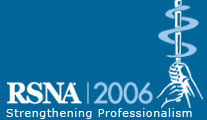
Abstract Archives of the RSNA, 2006
SSQ05-06
Impact of Oxygen Inhalation on Pulmonary Perfusion: Assessment by MR-Perfusion and -Flow Measurements
Scientific Papers
Presented on November 30, 2006
Presented as part of SSQ05: Chest (MR Imaging)
Sebastian Ley MD, Presenter: Nothing to Disclose
Michael Ulrich Puderbach MD, Abstract Co-Author: Nothing to Disclose
Frank Risse PhD, Abstract Co-Author: Nothing to Disclose
Julia Zaporozhan MD, Abstract Co-Author: Nothing to Disclose
Hans-Ulrich Kauczor MD, Abstract Co-Author: Nothing to Disclose
Michael Bock PhD, Abstract Co-Author: Nothing to Disclose
Monika Eichinger MD, Abstract Co-Author: Nothing to Disclose
Daisuke Takenaka MD, Abstract Co-Author: Nothing to Disclose
et al, Abstract Co-Author: Nothing to Disclose
In dyspnoic patients oxygen supply is sometimes needed during MRI studies of the chest. Oxygen enhanced MR-Ventilation imaging of the lung is based on the inhalation of oxygen. However, the potential effects of oxygen on the pulmonary circulation are unclear. Therefore, the goal of this study was to evaluate the influence of oxygen onto pulmonary perfusion.
10 healthy volunteers were examined (1.5T) with contrast enhanced 2D saturation-recovery Turboflash perfusion of the lung parenchyma and phase-contrast flow measurements in the pulmonary trunc. Both measurements were performed breathing room air (RA) and 100% oxygen (O2).
The perfusion measurements showed a significant difference between RA and O2 for the pulmonary blood flow (181 vs. 257 ml/min/100ml, p = 0.02) and blood volume (14 vs. 21 ml/100ml, p = 0.007). The mean transit time of the contrast bolus was not changed (p=0.2).
The mean heart rate was significantly different (p = 0.01) between RA (67 ± 11 beats/min) and O2 (61 ± 12 beats/min)). The average blood flow (pulmonary trunc) was significant lower while breathing O2 (RA: 5.9 vs. O2: 5.5 l/min, p = 0.047).
The administration of oxygen during MRI of the lung causes a significant change of pulmonary blood flow and volume. Thus oxygen should be avoided for the quantitative assessment of perfusion and flow using MRI. In the context of oxygen enhanced MRI of pulmonary ventilation the contribution of this effect needs further evaluation.
Oxygen should be avoided for quantitative assessment of perfusion and flow.
Ley, S,
Puderbach, M,
Risse, F,
Zaporozhan, J,
Kauczor, H,
Bock, M,
Eichinger, M,
Takenaka, D,
et al, ,
Impact of Oxygen Inhalation on Pulmonary Perfusion: Assessment by MR-Perfusion and -Flow Measurements. Radiological Society of North America 2006 Scientific Assembly and Annual Meeting, November 26 - December 1, 2006 ,Chicago IL.
http://archive.rsna.org/2006/4436902.html

